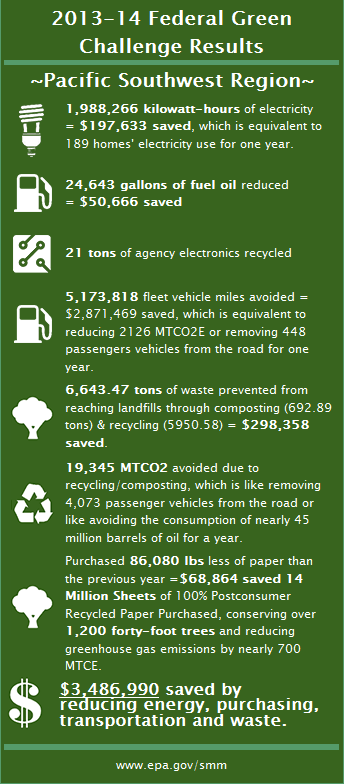2015 Federal Green Challenge Award Winners in the Pacific Southwest Region

Recognition is an important part of the Federal Green Challenge (FGC). Awards are given at the regional level in the categories of Overall Achievement, Innovation, Education & Outreach, and Leadership.
California's drought makes federal leadership on water conservation critical. EPA encourages all federal facilities and employees to expand water conservation efforts.
Overall Achievement
Hawai’i Volcanoes National Park, HI
Hawai΄i Volcanoes National Park is one of the most fascinating biologically-diverse landscapes in the world. Located more than 2,000 miles from the nearest continental land mass, the park stretches from the summit of Mauna Loa at 13,677 feet to sea level.
The park had top regional achievements in both the Federal Green Challenge Purchasing and Waste target areas, increasing recycling by 167 percent, reducing landfilling by 48 percent, and decreasing paper purchases by 89 percent, all while ensuring that 95 percent of its cleaning products meet Environmental Preferable Purchasing criteria.
The park also actively works to reduce their environmental footprint in 4 of the 6 Federal Green Challenge target areas.
Leadership
U.S. Forest Service, Region 5, Vallejo, CA
The Forest Service Region 5 2014 Sustainable Operations Microgrant program encouraged bottom-up leadership to promote education and achieve environmental results.
A series of microgrants inspired employees to develop and implement local, sustainable activities. In fiscal year 2014, Region 5 provided $32,556 in microgrant funds of up to $2,000 per project to implement 25 projects.
The Microgrant Program will achieve a payback within 2 years with a 290 percent “return on investment” of $94,711 in 5 years. The projected annual savings from the 25 projects are as follows:
- $18,942.29 cost savings,
- 1,181,015 gallons of water, and
- 37,837 kWh of energy.
Purchasing
U.S. Courthouse, General Services Administration (GSA), Los Angeles, CA
The U.S. Courthouse, General Services Administration (GSA), Los Angeles, increased their purchase of green cleaning products by 60% at its 880,000 square foot facility by strengthening requirements in their custodial services contract. The custodial contractor, a nonprofit corporation that provides vocational rehabilitation and employment for developmentally disables adults, now uses 90% green cleaning products. Reducing the use of harmful cleaning materials in the facility has not harmed the quality of the cleaning service. In addition, GSA reduced office paper purchases by 6.25% by removing personal printers and encouraging double-sided printing and uses copy paper that has 75% postconsumer recycled content.
Education and Outreach
Golden Gate National Recreation Area, San Francisco, CA
In May 2014, Golden Gate National Recreation Area (GGNRA) hosted an inaugural Bay Area Park Sustainability Summit to advance education and outreach on cutting-edge sustainability practices being implemented at parks. The Summit educated fifty-five participants.
Parks provide a direct interface with the public on sustainability education and can demonstrate green operations to reduce direct environmental impacts and inspire visitors to do the same. An electric vehicle demonstration and test drive using the GGNRA fleet was also provided.
To educate the public, the park participated in, and was a winner of, the National Park Service's "My Green Parks Video Contest". Exit
Innovation
Sacramento Valley National Cemetery, Dixon, CA
The Sacramento Valley National Cemetery used innovative water conservation practices and equipment to reduce potable and landscaping water use by over 14 million gallons or 27 percent in 2014 compared to 2013. This reduction is significant since the 561-acre cemetery will serve area veterans for the next 50 years.
The facility researched and deployed innovative water conservation practices that address the drought in California by:
- Purchasing and using a moisture sensor to measure the moisture of the turf area. This tool is inserted into the turf to determine when watering the turf is necessary (below 20 percent moisture reading).
- Actively re-programming and turning off the irrigation system after rain events.
- Auditing the sprinkler system and re-aligning all irrigation heads to ensure that no water is wasted.

